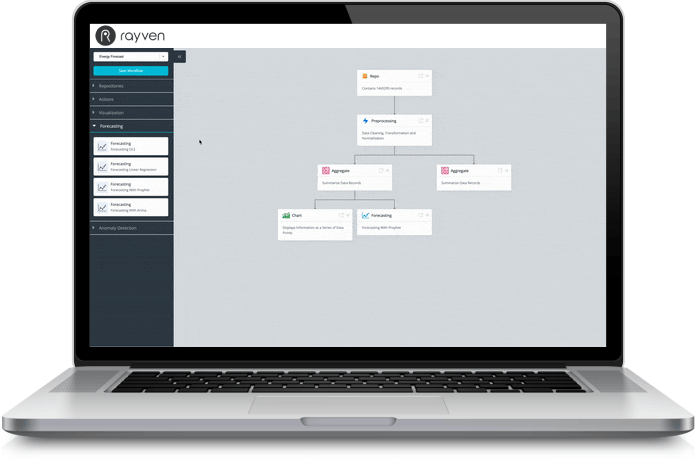Rayven.io’s Machine Learning (ML) capabilities are fully integrated with its combined AI + IoT platform, allowing users to build and implement predictive analytics seamlessly within their real-time IoT solutions.
)
Key Features of Rayven’s Machine Learning Workbench
-
Drag-and-Drop Interface:
The ML workbench utilizes the same intuitive drag-and-drop interface as the Workflow Builder, ensuring consistency across the platform. This means users can easily add ML capabilities to their workflows and solutions without needing specialized coding knowledge. -
Three Machine Learning Model Options: Rayven provides three approaches to integrating machine learning models:
- Ready-to-go Models: Utilize Rayven’s pre-built models tailored for common use cases such as forecasting, anomaly detection, and predictive maintenance.
- Custom Model Creation: Build your own model directly within the Rayven platform, selecting data from your existing workflows and applying algorithms tailored to your specific needs.
- Python Model Import: For advanced users, import Python-based models you’ve developed outside the platform, allowing for deep customization and application of pre-existing ML models.
-
Real-time Optimization:
Machine learning in Rayven is fully integrated with the IoT platform, meaning your models continuously learn from real-time data. The results of ML processes are instantly available within workflows, enabling dynamic optimization of processes and solutions. -
Seamless Integration with IoT:
Rayven’s AI + IoT platform ensures no data gaps between machine learning models and the real-time monitoring and control systems you build. This results in reduced complexity, more efficient solutions, and superior outcomes for IoT use cases.
Adding Machine Learning to Your Solution
Rayven’s AI Dynamix predictive analytics engine is designed for ease of use, leveraging the same drag-and-drop functionality as the Workflow Builder. It allows users to collect data from any system and incorporate ML into real-time IoT monitoring and management solutions effortlessly.
By integrating ML, you can create advanced predictive models that help automate decision-making, predict outcomes, and optimize system performance over time.
Implementing Machine Learning: The 6-Step Process
-
Prepare Your Data:
Select the training data from your workflows, and apply filters and normalizers from Rayven’s built-in tools. The ML Workbench provides several ready-to-go data preparation options to simplify the process. -
Choose or Build Your Algorithm:
You can either create an algorithm within the platform or import a Python-based one tailored to your specific use case. Rayven’s platform supports a variety of algorithms suitable for forecasting, anomaly detection, predictive maintenance, and more. -
Train the Algorithm:
Apply your algorithm to the prepared data and train it offline. The model will learn from historical data to produce insights and predictions tailored to the questions you pose. -
Deploy the Model:
Once trained, deploy the model within the Workflow Builder using the Machine Learning node. This seamlessly integrates predictive analytics into your existing workflows. -
Optimize Over Time:
As real-time data continues to flow into your system, both you and your algorithm will learn from any missed anomalies or breakdowns. AI Dynamix provides an easy way to iterate and improve models as the solution evolves. -
Compare Models:
Run multiple models simultaneously to test their performance against one another. The platform supports running concurrent models for different use cases, allowing you to evaluate the best approach for your specific needs.
Use Cases
-
Predictive Maintenance:
Use ML models to predict equipment failures before they happen, reducing downtime and maintenance costs. -
Anomaly Detection:
Detect outliers in data streams to identify potential issues in real-time, preventing failures or inefficiencies. -
Forecasting:
Use machine learning to predict future trends, whether it’s demand forecasting, energy consumption, or inventory levels, to make proactive decisions. -
Custom Workflows:
Build your own custom ML workflows to automate decision-making and optimize processes across various industries and use cases.
Conclusion
Rayven.io’s Machine Learning Workbench provides a fully integrated, flexible solution for adding predictive analytics and optimization to your IoT and real-time applications. With options for pre-built models, custom models, and Python-based imports, the platform caters to a wide range of use cases and technical capabilities. By embedding ML into Rayven workflows, users can leverage real-time data to continually optimize and improve their operations, creating smarter, more efficient solutions.
